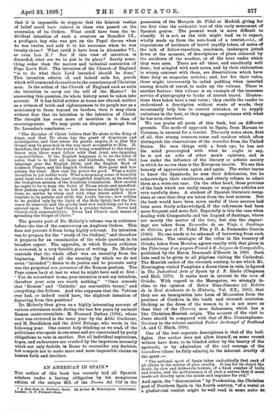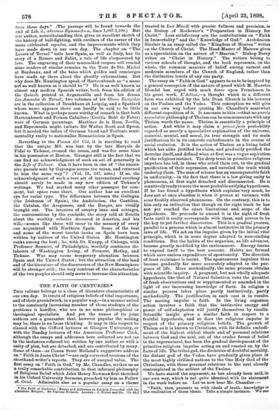AN AMERICAN IN SPAIN.*
THE author of this book has recently laid all Spanish scholars under a lasting obligation by his sumptuous edition of the unique MS. of the Poema del Cid in the • d Note-Book in Northern Spain. By Archer Y. Huntington. Illustrated. London G. P. Putnam's Sons.
possession of the Marquis de Pidal at Madrid. giving for- the first time the authentic text of this early monument of Spanish genius. The present work is more difficult to
classify. It is not, as the title might lead us to expect, wholly made up from the note-book of a tourist,—i.e., of impressions of incidents of travel rapidly taken, of notes of the talk of fellow-travellers, coachmen, innkeepers jotted down at the moment, of descriptions of place coloured by the accidents of the weather, or of the hour under which they were seen. There are all these, and excellently well
done ; but mingled with such notes, and by their elaboration in strong contrast with them, are dissertations which have
done duty as magazine articles ; and, but for their value, these might irreverently be called padding when inserted
among details of travel, to make up the volume. There is another feature : this volume is an example of the immense service of photography to books of tourist travel. Illustra- tions thus taken have a real value ; they enable the reader to understand a description without waste of words, they occasionally help him to correct mistakes, or to supply
omissions in the text, or they suggest comparisons with what he has seen elsewhere.
We can praise all parts of this book, but on different grounds. The mode of approach to Spain, from Havana to• Corunna, is unusual for a tourist. The early notes show, first of all, that strong common-sense and candour which often distinguish the observations of the traveller from the United States. He sees things with a fresh eye, he has not
his mind preoccupied with what he ought to say, he is not an echo of other men's opinions, and is less under the influence of the literary or artistic society in which he moves than is the European tourist. We see this honesty of appreciation again and again. The writer learns to know the Spaniards, he sees their deficiencies, but he acknowledges their excellences, and utterly refuses to admit them as a worn-out race. On the other hand, those portions of the book which are really essays or magazine articles are very carefully done. A student of Spanish literature recog- nises at once that they are taken from the best sources. But the book would have been more useful if these sources had been more freely acknowledged, if the references had been more frequent and more full. Especially is this the case when
dealing with Compostella and the Legend of Santiago, where not merely the matter of the text, but also the engrav- ings are taken from Recuerdos de un Viaje a Santiago
de Galicia, por el P. Fidel Fita y D. A. Fernandez Guerra (1880). No one needs to be ashamed of borrowing from such authorities. The catalogue of the relics in the treasury of Oviedo, taken from Morales, agrees exactly with that given in the Pelerinage d'un paysan Picard a S. Jacques de Compostellov published by the Baron Boursanit d'Houett in 1890. Such lists need to be given to all pilgrims visiting the Cathedral. The Moorish casket of the eleventh century, to see which Mr_ Huntington visited Pamplona a dozen times in vain, is figured in The Industrial Arts of Spain by J. F. Riano (Chapman and Hall, 1873). It ranks next in interest to the arca of Oviedo. With regard to the Maragatos, we strongly in. cline to the opinion of Senor Dias-Jimenez (cf. Boletin de la Real Academia de la Historic, Vol. XX., 1892), that they are an immigration into Leon of Mozarabes from the province of Cordova in the tenth and eleventh centuries. Striking as the dress of the women is, it is not more so than that of the Charras, near Salamanca, which has a like Christian-Moorish origin. The account of the visit to
Juste should be compared with that of Mrs. Cunninghame- Graham in the volume entitled Father Archangel of Scotland (A. and C. Black, 1896).
One of the beat separate descriptions is that of the bull. fights. Our author does not allow himself, as some recent writers have done, to be blinded either by the beauty of the spectacle, or by admiration of the cool courage of the toreadores (these he fully admits), to the inherent cruelty of
the sport :-
" The national sport of Spain takes undoubtedly first rank of all others in the matter of pure cruelty. It has for its object the death, by slow and deliberate torture, of a fixed number of bulls and horses, and the performance is of such a nature that it must needs act directly upon the minds and impulses for evil."
And again, the " denunciation " by Prudentins, the Christian poet of Northern Spain in the fourth century, "of a vestal at a gladiatorial contest might be well read in some pako do, taros these days." (The passage will be found towards the end of Lib. ii., adversus Symmachurn, lines 1,087-1,100.) But our author, notwithstanding this, gives an excellent sketch of the history of bull-fighting, with outlines of the career of the more celebrated espadas, and the improvements which they have made down to our own day. The chapter on " The Lovers of Teruel " tells how Spain, as well as Italy, has its story of a Romeo and Juliet, a tale of life o'erpowered by love. The engraving of their mummified corpses will remind some readers of similar remains in the Tour de Ste. Michel at Bordeaux, and of the tales which guides and concierges have made up there about the ghastly exhumations. But why does Mr. Huntington speak of Hart zenbusch as " a name not so well known as it should be " ? He is as well known as almost any modern Spanish writer, both from his edition of the Quixote printed at Argamasilla and from his drama Los Amantes de Teruel; two volumes of his Obras Escogidas are in the collection of Brockhaus at Leipzig, and a Spaniard whose name appears there can hardly be said to be little known. What is perhaps more worthy of remark is that both Hartzenbusch and Fernan Caballero (Cecilia Bohl de Faber) were of German parentage. Martinez de la Rosa, Zorilla, and Espronceda might imitate Sir Walter Scott and Byron, but it needed the influx of German blood and Teutonic senti- mentality really to nationalise Romanticism in Spain.
Reverting to the Poema del Cid, it is startling to read that the unique MS. was lent by the late Marquis de Fidel to Ticknor, crossed the ocean, and was for some time in his possession at Boston. Stranger still is the fact that we can find no acknowledgment of such an act of generosity in the Life of Ticknor. Can it have been in one of " the succes- sive parcels sent by Gayangos across the ocean, and returned to him the same way "? (Vol. IL, 247, note.) If so, the acknowledgment of such a rare act of international courtesy should surely be made in any new edition of Ticknor's writings. We had marked many other passages for com- ment, but space runs short. Our author has an excellent eye for racial type. The differences between the Gallegan (the Irishman of Spain), the Andalucian, the Castilian, the Catalan, the Aragonese, and the Basque, are vividly brought out. The interiors of country inns and cottages, the conversations by the roadside, the story told at Estella about the wealthy relative deceased in America, and his will,—scenes like these will recur to the memory of every one acquainted with Northern Spain. Some of the best and some of the worst tourist books on Spain have been written by natives of the United States. Mr. Huntington ranks among the best ; he, with Dr. Knapp, of Chicago, with Professor Rennert, of Philadelphia, worthily continues the labours of Washington Irving, of Prescott, Motley, and Ticknor. War may cause temporary alienation between Spain and the United States ; but the attraction of the land and of the literature of the discoverers of the New Hemisphere will be stronger still ; the very contrast of the characteristics of the two peoples should only serve to increase this attraction.



































 Previous page
Previous page